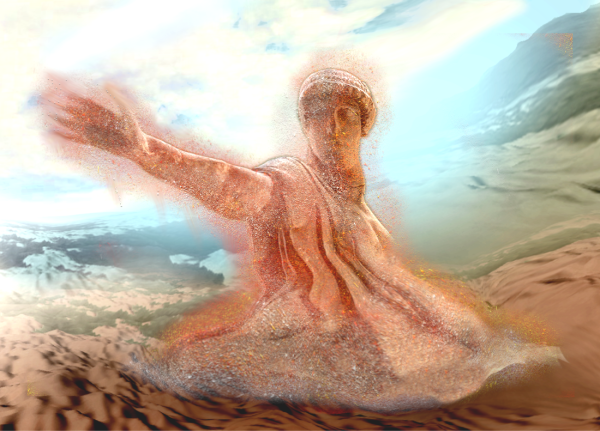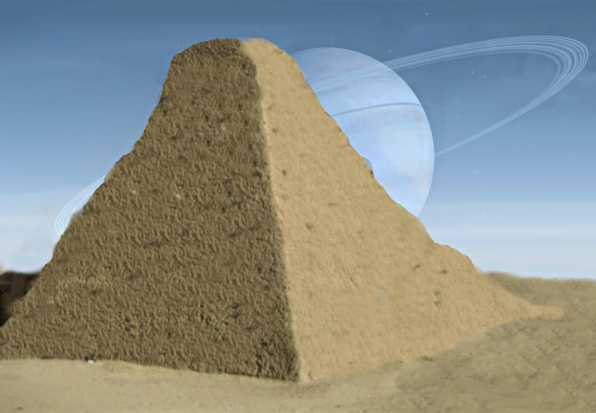BY LETTER
Utility Sand
Technology > Technology Type or Material > Drytech/Hylotech
Technology > Application > Envirotech
Technology > Technology Levels > High Tech / Hitech
Technology > Application > Envirotech
Technology > Technology Levels > High Tech / Hitech
A dense, load bearing form of utility fog | |
 Image from Steve Bowers | |
| Some sophonts use bodymorphs which consist entirely of Utility Sand, though many prefer to wrap this in a softer layer of utility fog that can mimic flesh more accurately | |
Utility Sand, as the name implies, is a heavy duty variant of utility fog and used where superior compressive strength is required. The individual units of U-sand are far too large to be called foglets and, given its most common use, are referred to as sandlets instead. The morphology of a sandlet is also different from a foglet. It has a body about one millimetre across, large enough to be seen by the unaided baseline eye, and lacks the grasping arms found on foglets. As such, U-sand has the density of clay and cannot retract out of the way of moving objects (like Ufog can) and is instead used where more permanent structures are needed. Utility Sand generally incorprates a shell of Corundumoid or silicates, which makes U-sand highly fire-resistant.
However the sandlets can flow over and crawl up each other to build up new features or carve out openings in the U-sand construct. This is achieved with hundreds of geckotech equipped, piezoelectric powered, cilia. The geckotech allows the sandlets to cling to each other with enough strength to easily form vertical walls,or inverted structures over short distances (even though they lack the grippers of standard foglets) but when the van der Waals attraction is control and coordinated with the beating of the cilia the sandlets can roll in any direction across the surface. Even quick movement of large amounts of U-sand is possible by employing the same techniques used by riverroads. It should also be noted that because the piezoelectric effect works both ways the cilia can not only cause movement of the sandlets but can also be used to recharge a sandlet when it is moved by others.
Utility Sand is most commonly used in the construction of low-rise buildings like homes but it can also be used in the interior of larger buildings. This limitation is because U-sand, when at rest, has the bulk properties of adobe or rammed earth. It is stronger in compression than in tension unless reinforced by some means, so the higher a wall of U-sand gets the thicker it needs to be at its base to support itself. Like the stone or brick buildings of old a point is reached in building higher where you lose too much floor space on the lower levels when adding more top floor space. Ceilings of U-sand are still possible if the material is kept in compression by using vaults. Of course when active the properties of U-sand make it a superior building material to adobe or rammed earth. With a cost of some input of energy the geckotech can make the bonds between the sandlets stronger, the shapeshifting U-sand can form doors and windows in walls on command, furniture can emerge as needed and when used as flooring the cilia give it the same functions as flo-stone.
Although the use of Utility Sand for hard furnishings like tables or counters is an obvious application it can also be used in comfort items like chairs or beds. The ability of U-sand to flow on command means it can adapt and conform to the shape of a user to provide firm but comfortable support as well as generating heat and a vibrating massage. Lying on a U-sand bed is much more comfortable than lying on a blanket at the beach. U-sand beds are also often used for hygiene maintenance: As a user sleeps a blanket of sandlets crawls over them and gently rubs away any dirt, sweat or excess oil.
Utility Sand may also be used on a personal level. Several nanocyborg clades exploit the compressive strength of U-sand in supporting frames and/or protective coverings. For example, a nanocyborg who practices biomimetics can use U-sand fashioned into an articulated skeleton. Overlaying this with Ufog in an analog of muscles gives the nanocyborg the look and movements that realistically duplicate those of a natural biont while retaining the full ability to shapeshift.
Other sophonts prefer to use bodies which consist solely of Utility sand, and may adopt bodyforms inspired by architecture or geological formations.
 Image from Steve Bowers |
Related Articles
Appears in Topics
Development Notes
Text by AI Vin
Initially published on 06 March 2008.
Initially published on 06 March 2008.






